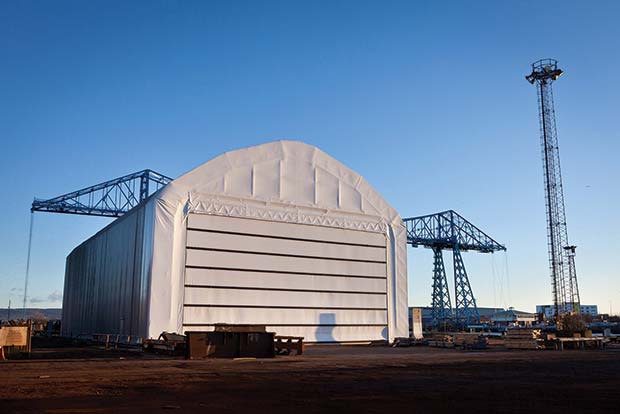The Swan Hunter Shipyard buildings that were located in the dockyards on the banks of the River Tyne are well known as an iconic industrial image of the North East, after dominating the Newcastle skyline for more than 25 years.

Originally manufactured by Rubb Buildings Ltd back in 1982, the two BVL structures measuring 27m span x 24m long with 11.7m high sidewalls, were used to house the ships being manufactured by Swan Hunter. When shipbuilding ceased at the Wallsend yard, the structures were dismantled and placed in storage.
In 2014 they are now erected and back in service at Wilton Engineering Services. The company specialises in engineering design, fabrication/construction, analysis, and coatings for the energy industry by the River Tees in Middlesbrough.
The buildings were originally designed with a roller and track system to allow the building to slide along the dock. Wilton did not require the buildings to be moved and therefore did not install them with the roller system. The two buildings were designed to butt against each other to form one large enclosure, and also had a removable gable end which could be retro fitted to fully enclose the area. Wilton installed the two buildings together to effectively form one building, the front gable clad with new PVC sheets manufactured by Rubb. Wilton left one gable end open to allow parts and equipment to be easily transported in and out of the building for shot blast and painting.
Wilton approached Rubb to come up with a solution to fully enclose the building and provide a door system that would give a clear opening of approximately 21m wide by 10m high. Rubb provided a Heli-Door system (21.35m wide x 9.7m high clear opening) with rakers to enable the wind load to be transferred straight to the foundations. This avoided the need to alter the existing building system to accommodate the point load from the door prop. As part of the scheme Rubb was required to provide a gable infill, which was a shortened version of the previously designed full gable system.
The hot dip galvanized steel framework of the Rubb structures has proved to be long-lasting and durable – at 32 years old, the structures are still able to perform in all climates. The long life and continued re-use of these industrial fabric structures is an example of the longevity, value and flexibility of Rubb structures.
Sales Manager Andy Knox said: “It’s great to see these buildings back in operation. This, along with the fact that they have lasted 32 years in challenging industrial environments, is testament to the design and quality we produce here at Rubb.”
Clare Wilson Marketing Manager
Tel: 0191 482 2211
Email: c.wilson@rubb.co.uk





Comments are closed.